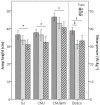Physical and physiological characteristics of elite male handball players from teams with a different ranking
- PMID: 24235989
- PMCID: PMC3827752
- DOI: 10.2478/hukin-2013-0051
Physical and physiological characteristics of elite male handball players from teams with a different ranking
Abstract
The aim of this study was to examine possible discriminant physical and physiological characteristics between elite male handball players from elite teams with different league rankings. Players from three teams (A, B and C), which competed in the first league of the Greek championship during the season 2011-2012 participated in the study. Team A finished first, B came second and C came eighth out of eleven clubs. Teams A and B also participated in European Cups, and team A won the European Challenge Cup. The players (n=44) were examined for anthropometric characteristics and performed a series of physical fitness tests. Players from teams A and B were taller (6.2 cm (0.7;11.7), mean difference (95% CI) and 9.2 cm (4.0;14.5), respectively), and had a higher amount of fat free mass (6.4 kg (1.1;11.8) and 5.4 kg (0.2;10.5)) compared to those of team C. Players from team A performed better than players from team C in the squat jump (5.5 cm (1.0;10.0)), the countermovement jump without (5.5 cm (0.4;10.6)) and with arm-swing (6.0 cm (0.7;11.3)) and in the 30 s Bosco test (5.7 W·kg-1 (1.2;10.2)). Also, players from team A outperformed team B in mean power during the Wingate anaerobic test (WAnT, 0.5 W·kg-1(0;0.9)) and in the Bosco test (7.8 W·kg-1 (3.4;12.2)). Overall, players from the best ranked team performed better than the lowest ranked team on WAnT, vertical jumps and the Bosco test. Stepwise discriminant analysis showed that stature and mean power during the Bosco test were the most important characteristics in TH players, accounting for 54.6% of the variance in team ranking. These findings indicate the contribution of particular physical fitness components (stature, fat free mass and anaerobic power) to excellence in TH. In addition, the use of the Bosco test as an assessment tool in talent identification and physical fitness monitoring in this sport is further recommended.
Keywords: anaerobic power; anthropometry; discriminant variables; handball; physical fitness; sport excellence.
Figures

Similar articles
-
Physical and physiological characteristics in male team handball players by playing position - Does age matter?J Sports Med Phys Fitness. 2015 Apr;55(4):297-304. Epub 2014 Oct 10. J Sports Med Phys Fitness. 2015. PMID: 25303066
-
Anthropometric Characteristics, Physical Fitness, and Throwing Velocity in Elite women's Handball Teams.J Strength Cond Res. 2018 Aug;32(8):2294-2301. doi: 10.1519/JSC.0000000000002412. J Strength Cond Res. 2018. PMID: 30044343
-
Who jumps the highest? Anthropometric and physiological correlations of vertical jump in youth elite female volleyball players.J Sports Med Phys Fitness. 2017 Jun;57(6):802-810. doi: 10.23736/S0022-4707.16.06298-8. Epub 2016 May 3. J Sports Med Phys Fitness. 2017. PMID: 27139794
-
Performance factors in women's team handball: physical and physiological aspects--a review.J Strength Cond Res. 2013 Jun;27(6):1708-19. doi: 10.1519/JSC.0b013e3182891535. J Strength Cond Res. 2013. PMID: 23439330 Review.
-
Anthropometric and Physical Qualities of Elite Male Youth Rugby League Players.Sports Med. 2017 Nov;47(11):2171-2186. doi: 10.1007/s40279-017-0745-8. Sports Med. 2017. PMID: 28578541 Free PMC article. Review.
Cited by
-
Multi Directional Repeated Sprint Is a Valid and Reliable Test for Assessment of Junior Handball Players.Front Physiol. 2018 Apr 4;9:317. doi: 10.3389/fphys.2018.00317. eCollection 2018. Front Physiol. 2018. PMID: 29670536 Free PMC article.
-
Basketball talent identification: a systematic review and meta-analysis of the anthropometric, physiological and physical performance factors.Front Sports Act Living. 2023 Nov 14;5:1264872. doi: 10.3389/fspor.2023.1264872. eCollection 2023. Front Sports Act Living. 2023. PMID: 38033652 Free PMC article. Review.
-
Relative Age Effect is Modulated by Playing Position but is Not Related to Competitive Success in Elite Under-19 Handball Athletes.Sports (Basel). 2019 Apr 19;7(4):91. doi: 10.3390/sports7040091. Sports (Basel). 2019. PMID: 31010139 Free PMC article.
-
Vertical jump neuromuscular performance of professional female handball players-starters vs. non-starters comparison.Front Sports Act Living. 2024 May 9;6:1407601. doi: 10.3389/fspor.2024.1407601. eCollection 2024. Front Sports Act Living. 2024. PMID: 38783868 Free PMC article.
-
Bioelectrical Impedance Vector Analysis of Young Elite Team Handball Players.Int J Environ Res Public Health. 2021 Dec 8;18(24):12972. doi: 10.3390/ijerph182412972. Int J Environ Res Public Health. 2021. PMID: 34948582 Free PMC article.
References
-
- Adam C, Klissouras V, Ravazzolo M, Renson R, Tuxworth W. The Eurofit Test of European Physical Fitness Tests. Strasbourg: Council of Europe; 1988.
-
- Aragon-Vargas LF. Evaluation of four vertical jump tests: Methodology, reliability, validity, and accuracy. Meas Phys Educ Exerc Sci. 2000;4:215–228.
-
- Bar-Or O, Skinner JS. Wingate anaerobic test. Champaign: Human Kinetics; 1996.
-
- Bencke J, Damsgaard R, Saekmose A, Jorgensen P, Jorgensen K, Klausen K. Anaerobic power and muscle strength characteristics of 11 years old elite and non-elite boys and girls from gymnastics, team handball, tennis and swimming. Scand J Med Sci Sports. 2002;12:171–178. - PubMed
-
- Bland J, Pfeiffer K, Eisenmann JC. The PWC170: comparison of different stage lengths in 11–16 year olds. Eur J Appl Physiol. 2012;112:1955–1961. - PubMed
LinkOut - more resources
Full Text Sources
Other Literature Sources
